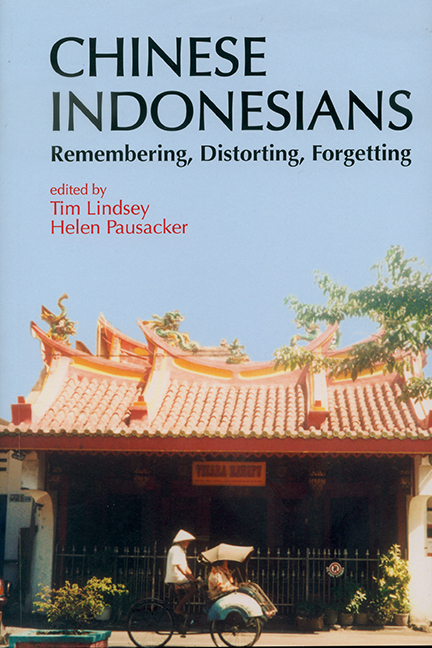Book contents
- Frontmatter
- Contents
- Preface
- A Brief Biography
- Contributors
- Glossary
- Introduction: Researching the Margins
- Bibliography of Charles Coppel's Work
- 1 Anti-Chinese Violence and Transitions in Indonesia: June 1998–October 1999
- 2 Reconstituting the Ethnic Chinese in Post-Soeharto Indonesia: Law, Racial Discrimination, and Reform
- 3 Buddhism and Confucianism in Contemporary Indonesia: Recent Developments
- 4 Portrait of the Chinese in Post-Soeharto Indonesia
- 5 The Makam Juang Mandor Monument: Remembering and Distorting the History of the Chinese of West Kalimantan
- 6 Confucianists and Revolutionaries in Surabaya (c1880–c1906)
- 7 The Chinese and the Early Centuries of Conversion to Islam in Indonesia
- 8 The Agony of Love: A Study of Peranakan Chinese Courtship and Marriage
- 9 Peranakan Chinese and Wayang in Java
- Index
Introduction: Researching the Margins
Published online by Cambridge University Press: 21 October 2015
- Frontmatter
- Contents
- Preface
- A Brief Biography
- Contributors
- Glossary
- Introduction: Researching the Margins
- Bibliography of Charles Coppel's Work
- 1 Anti-Chinese Violence and Transitions in Indonesia: June 1998–October 1999
- 2 Reconstituting the Ethnic Chinese in Post-Soeharto Indonesia: Law, Racial Discrimination, and Reform
- 3 Buddhism and Confucianism in Contemporary Indonesia: Recent Developments
- 4 Portrait of the Chinese in Post-Soeharto Indonesia
- 5 The Makam Juang Mandor Monument: Remembering and Distorting the History of the Chinese of West Kalimantan
- 6 Confucianists and Revolutionaries in Surabaya (c1880–c1906)
- 7 The Chinese and the Early Centuries of Conversion to Islam in Indonesia
- 8 The Agony of Love: A Study of Peranakan Chinese Courtship and Marriage
- 9 Peranakan Chinese and Wayang in Java
- Index
Summary
To study the ethnic Chinese in Indonesia might be thought a marginal enterprise. The Chinese overseas have long been an exotic interest in Chinese studies, outside the Sinological mainstream, with its thousands of years of historical sources and commentaries. This is perhaps especially so in the case of Indonesia's Chinese minority, with its large numbers of acculturated, peranakan Chinese, who from the perspective of China scarcely seem to merit the description “Chinese”. In Indonesian studies, too, they have been seen as marginal. This is not only because they are but one ethnic group among hundreds, comprising a mere 2 or 3 per cent of the total population, but also because they have been constructed as “foreign”, no matter how many centuries they have been settled in the archipelago.
Many Chinese Indonesians themselves have been marginalized and felt alienated from the surrounding society in their own life experience. This has not only applied when they were classified in Dutch law as “Foreign Orientals” (even if they were “Netherlands subjects”) and in Indonesian law as “of foreign descent” and not “indigenous” (even if they were Indonesian citizens) (Coppel 1999c and 2001). It has also applied to many of those Chinese Indonesians who “returned” to what they believed to be their motherland, only to discover that in China, too, they were “foreign” and treated differently from the rest of the population (Coppel 1990a).
Greg Dening (1980, p. 3) writes of islands and beaches as “a metaphor for the different ways in which human beings construct their worlds and for the boundaries that they construct between them”. My islands are Sinology and Indonesian studies, and the study of the Chinese in Indonesia is the study of the beaches, liminal spaces between the two.
- Type
- Chapter
- Information
- Chinese IndonesiansRemembering, Distorting, Forgetting, pp. 1 - 9Publisher: ISEAS–Yusof Ishak InstitutePrint publication year: 2005



